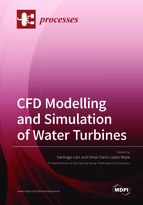CFD Modelling and Simulation of Water Turbines
A special issue of Processes (ISSN 2227-9717). This special issue belongs to the section "Energy Systems".
Deadline for manuscript submissions: closed (31 October 2022) | Viewed by 25769
Special Issue Editors
Interests: CFD; numerical methods; turbulence; two-phase flow; renewable energy
Special Issues, Collections and Topics in MDPI journals
Interests: CFD; RANS and hybrid RANS-LES turbulence modelling; computational aerodynamics; renewable energy
Special Issues, Collections and Topics in MDPI journals
Special Issue Information
Dear Colleagues,
The increase in the computational power and capacity of the current computers has accelerated the application of numerical methods, in particular CFD, in order to handle complex problems arising in industrial and environmental contexts. The design, analysis, development, and troubleshooting of water turbines is one specific application that has greatly benefited from such a rapid advance of numerical methods.
This Special Issue titled “CFD Modelling and Simulation of Water Turbines” aims to present recent novel research trends based on advanced CFD techniques for water turbines. The following topics, among others, will be included in this Issue:
- CFD numerical methods (i.e., URANS, LES, hybrid, DNS, etc.) applied to simulation of water turbines
- Performance of dynamic meshes (sliding mesh, overset mesh, IBM, etc.)
- Unsteady and transient phenomena in water turbines
- Design and optimization of water turbines
- Wake development and recovery
- Interaction turbine - free surface dynamics
- Conventional (i.e., hydraulic machines) and non-conventional turbines (e.g., hydrokinetic)
- Fluid–structure interaction
- Two-phase phenomena in water turbines (e.g. erosion and cavitation)
We look forward to receiving your contribution to this Special Issue.
Prof. Dr. Santiago Lain
Dr. Omar Dario Lopez Mejia
Guest Editors
Manuscript Submission Information
Manuscripts should be submitted online at www.mdpi.com by registering and logging in to this website. Once you are registered, click here to go to the submission form. Manuscripts can be submitted until the deadline. All submissions that pass pre-check are peer-reviewed. Accepted papers will be published continuously in the journal (as soon as accepted) and will be listed together on the special issue website. Research articles, review articles as well as short communications are invited. For planned papers, a title and short abstract (about 100 words) can be sent to the Editorial Office for announcement on this website.
Submitted manuscripts should not have been published previously, nor be under consideration for publication elsewhere (except conference proceedings papers). All manuscripts are thoroughly refereed through a single-blind peer-review process. A guide for authors and other relevant information for submission of manuscripts is available on the Instructions for Authors page. Processes is an international peer-reviewed open access monthly journal published by MDPI.
Please visit the Instructions for Authors page before submitting a manuscript. The Article Processing Charge (APC) for publication in this open access journal is 2400 CHF (Swiss Francs). Submitted papers should be well formatted and use good English. Authors may use MDPI's English editing service prior to publication or during author revisions.
Keywords
- unsteady Reynolds averaged Navier–Stokes (URANS)
- large eddy simulation (LES)
- direct numerical simulation (DNS)
- hybrid methods
- turbulent transient flow
- dynamic mesh techniques
- wake dynamics
- free surface dynamics
- erosion
- cavitation







